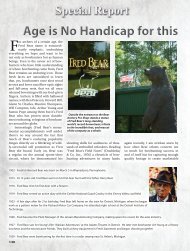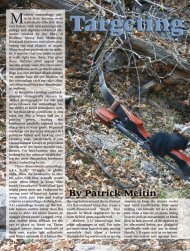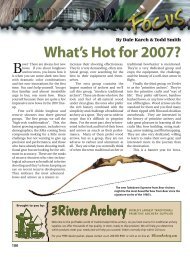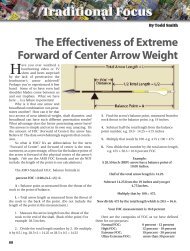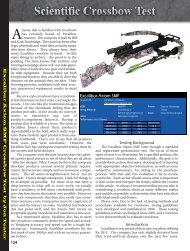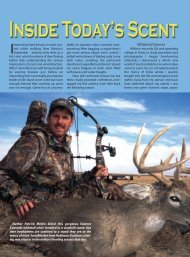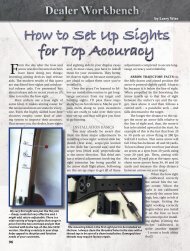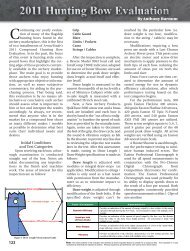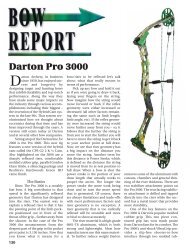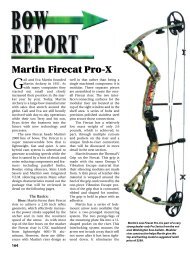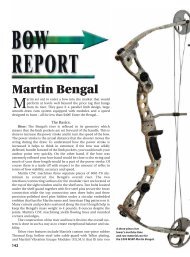Arrow Rest Tech 101 - Arrow Trade Magazine!
Arrow Rest Tech 101 - Arrow Trade Magazine!
Arrow Rest Tech 101 - Arrow Trade Magazine!
Create successful ePaper yourself
Turn your PDF publications into a flip-book with our unique Google optimized e-Paper software.
What’s touching your arrow<br />
after the string is released?<br />
The answer, of course, is<br />
the string and the arrow rest. That<br />
makes both of them rather important,<br />
doesn’t it? Lots of articles have<br />
been written on getting the nock-fit<br />
correct and the nocking point located<br />
to yield the best groups but this<br />
article is about the arrow rest.<br />
Choosing the best rest for a given<br />
set-up and its shooter is critical to<br />
archery accuracy. The proper match<br />
between the rest and arrow ensures a<br />
good consistent launch. Without<br />
that, tight groups are not possible<br />
and high scores, or at least scores<br />
that match the shooter’s ability,<br />
won’t happen. Without a proper<br />
match between shaft and rest your<br />
bowhunting customers won’t hit<br />
where they are aiming and that’s bad<br />
for all hunters so we have to do our<br />
best to get it right from the start.<br />
There are hundreds of arrow<br />
rests on the market today. They all<br />
work but some will work better for<br />
your bow and arrows than others.<br />
And the same goes for each of your<br />
customers. You need to find those<br />
rests, stock some of them and help<br />
each customer choose the one that<br />
works best for their setup. After all,<br />
he’s going to pay for your knowledge<br />
and experience.<br />
Presenting this basic guide in<br />
arrow rest selection and installation<br />
will ease this sometimes-difficult<br />
choice. I wish I could give you “the”<br />
answer but there is no “magic” rest<br />
out there. Not even on my bow. I<br />
have my favorites but each time I get<br />
a new bow to shoot, I have to cycle<br />
through several different rest types<br />
to find the one that does the job on<br />
that bow. And every now and then I<br />
even get out an old “springy” rest<br />
(Some of you never heard of it I suppose)<br />
and shoot it just to satisfy my<br />
curiosity. And the rest on my hunting<br />
108<br />
bow is different than what I use for<br />
targets.<br />
REST SELECTION<br />
The release aid, with rope loop<br />
or without, releases the string without<br />
imparting much sideways or lateral<br />
movement to it. The string,<br />
therefore, moves straightforward on<br />
the power stroke with little left/right<br />
oscillation. Most of the oscillation is<br />
in the vertical plane causing many<br />
arrows to move up and down as they<br />
pass over the arrow rest.<br />
Releasing the string with fingers<br />
imparts a lateral movement to the<br />
string since the string must move<br />
around the fingers. If you’re righthanded<br />
it moves to the left about an<br />
inch as you relax your fingers. The<br />
By Larry Wise<br />
<strong>Arrow</strong> <strong>Rest</strong> <strong>Tech</strong> <strong>101</strong><br />
<strong>Arrow</strong> rests come in several different styles as shown in this collection of Golden Key<br />
rests. Starting on the left and moving clockwise you see a two-prong drop-away, a single<br />
launcher, a single launcher drop-away, a two-prong spring-tension rest and a slotted<br />
disk rest. Each has its application and ardent fans and all do the job of getting the arrow<br />
started on its path to the target.<br />
string oscillates laterally, as well as<br />
vertically on the power stroke.<br />
When selecting a rest, then, you<br />
need to know “fingers or release”. For<br />
fingers, the proper horizontal tension<br />
match must be achieved to<br />
dampen the left-right oscillation of<br />
the string and arrow. For release aids,<br />
the proper match must be achieved<br />
for the vertical oscillation with less<br />
attention paid to the horizontal.<br />
Please keep in mind though, that the<br />
match in both directions is important<br />
but a different emphasis is<br />
required for the two different styles<br />
of shooting.<br />
The Star Hunter by Golden Key<br />
and any cushion plunger type rest<br />
will give adjustability for the undersupport<br />
of the arrow and also for the
This has been the old stand-by arrow rest for years and many<br />
manufacturers make a model like it. It supports the arrow on the<br />
side and under the bottom. You can use it to shoot deer, fish, 3-D<br />
archery, as well as field, target and indoor archery tournaments.<br />
Its simple construction makes it easy to adjust, quick to tune, reliable<br />
and durable.<br />
side pressure. From there, a finger<br />
shooter can adjust point weight and<br />
center-shot location of the rest to get<br />
good groups.<br />
Many pro release shooters use<br />
just a launcher. At the most recent<br />
Lancaster Archery Indoor Classic I<br />
surveyed the arrow rests being used<br />
by the top forty-eight pros in attendance<br />
and found that at least fortyfive<br />
were using launchers. That’s<br />
because the launcher rest provides<br />
adjustability for the under-support<br />
The spring-loaded prong rest is another long-time favorite of<br />
hunters and target archers. Its prongs spread to fit any size shaft<br />
and its spring adjusts to tune its downward motion to the shaft<br />
you’re using. The surround style Whisker Biscuit has gained popularity<br />
over the last few years and gently guides and stabilizes the<br />
arrow as it passes through the bristles. And it’s quiet.<br />
of the arrow; the<br />
launcher flexes in<br />
the vertical plane.<br />
But those bowhunters have<br />
needs that are a little different. The<br />
hunter needs to hold the arrow on<br />
the rest through all kinds of weather,<br />
walking and climbing. He has to<br />
rope-pull his bow up to his tree<br />
stand and lower it back down again<br />
without disturbing the arrow rest.<br />
The hunter needs durability.<br />
The bowhunter, in most cases,<br />
must also support<br />
a heavier<br />
broadheadtipped<br />
arrow with<br />
larger fletching.<br />
He or she has to<br />
draw that arrow<br />
in all kinds of circumstances:<br />
uphill, downhill<br />
and with his body<br />
contorted in any<br />
imaginable posi-<br />
The launcher style rest has been very popular with target archers<br />
for many years. The launcher thickness can be adapted to the<br />
spine of the shaft you use to get good arrow flight and good<br />
groups. Many models offer an easy micro-adjustment for the center<br />
shot location so you can easily find the left/right position of<br />
the launcher that yields the best groups for you and your setup.<br />
The launcher should be set at a 30 to 40 degree angle with the<br />
horizontal to get best results. Trim the launcher support points if<br />
you plan to shoot small diameter arrow shafts.<br />
tion to get the<br />
shot for which<br />
he’s waited all<br />
season. So the<br />
choosing and<br />
tuning a hunter’s<br />
arrow rest is serious business.<br />
The hunter’s choice must be<br />
made between several styles of<br />
arrow rests: the single launcher type,<br />
the double launcher or springloaded<br />
prong type and the “allaround”<br />
or “surround” type rest.<br />
CENTER SHOT<br />
As you mount the rest on your<br />
bow, first set the center alignment.<br />
Finger shooters usually need their<br />
arrow-center lined up just outside of<br />
bow-center. In other words, just to<br />
the left (for right-handers) of the line<br />
in front of the string. This helps compensate<br />
for the string moving to the<br />
left to get around your fingers during<br />
the release.<br />
A true centerline setup for<br />
release shooters usually works best.<br />
When shot using a release aid, the<br />
string comes straight forward so<br />
there is no need for an off-center initial<br />
setting. To establish this initial<br />
centerline setting I visually line up<br />
the string with the string grooves in<br />
the wheels and move the rest left and<br />
right until the arrow projects in front<br />
109
of the string. I also use the machined<br />
left edge of the arrow shelf (I’m righthanded)<br />
as a guide by trying to align<br />
the arrow parallel to it.<br />
Be aware that most single cam<br />
bows don’t have a vertical string<br />
alignment. The top idler wheel on a<br />
one cam is usually set in the middle<br />
of the axle but the string groove for<br />
the bottom cam places the string in<br />
the left-most groove (for right handers).<br />
I usually set the center-shot so<br />
the arrow is parallel to the left<br />
machined edge of the arrow shelf<br />
and continue from there. Small<br />
adjustments while fine-tuning will<br />
help me get it set for best grouping.<br />
NOCKING POINT:<br />
The initial nocking point location<br />
should be about ¼ inch above<br />
level for most compounds and<br />
recurves. This sets the bottom of the<br />
arrow level or slightly above level<br />
with the under-support of the rest.<br />
A level nocking point is good for<br />
the “surround” style rests, like the<br />
Whisker Biscuit, that touch the<br />
110<br />
arrow shaft around its entire circumference.<br />
The arrow should pass<br />
through this style rest with equal<br />
contact around its circumference.<br />
This enhances arrow flight and prevents<br />
uneven wear on the rest.<br />
On launcher style rests setting<br />
the nocking point level or a little<br />
high allows the arrow to clear easily.<br />
Setting it too low will cause the arrow<br />
to crash into the rest resulting in bad<br />
arrow flight. The same is true of the<br />
drop-away style rests although<br />
there’s more distance for error on the<br />
low contact that might result.<br />
I recently helped with some<br />
high-speed video at Lancaster<br />
Archery Supply. The video of the<br />
drop-away rest showed, as expected,<br />
that the rest dropped after four or<br />
five inches of the shaft passed.<br />
However, the back half of the arrow<br />
was bending down as it passed the<br />
rest and came dangerously close to it<br />
and the arrow shelf. The bow’s owner<br />
adjusted the rest slightly upward and<br />
raised the nocking point so the arrow<br />
fletching had more clearance.<br />
You can easily set the nocking point for a drop-away rest. Hold the pull-cord back to<br />
bring the rest to its upright position, place your nocking square as you would for any<br />
other rest and set the nocking point to ¼ to 3/8 inch. This will position the arrow so its<br />
bottom is level with the bottom of the rest hole. Fine-tune the nocking point by watching<br />
the arrow flight and by gauging any wear on the whiskers.<br />
SETTING LAUNCHER ANGLE<br />
The arrow must pass cleanly<br />
over a launcher-type rest. To ensure<br />
that this happens the launcher must<br />
be installed with the proper angle,<br />
about 30-40 degrees above horizontal,<br />
to eliminate fletch contact and<br />
optimize arrow groups.<br />
Set this 30 to 40 degree angle as<br />
you install the rest on your bow. If<br />
you’re installing a twin prong rest<br />
then also spread the supports of the<br />
rest to allow for fletching clearance<br />
between them. I set the spread to<br />
about two-thirds of the arrow diameter.<br />
This angle matched with a a ¼<br />
to 3/8 high nocking point will give<br />
good results quickly.<br />
POWDER TEST<br />
Be sure to powder test any<br />
arrows to be shot regardless of the<br />
rest you are using. Use some whitepowder<br />
foot spray on the fletched<br />
end of the arrow. Shoot it into a<br />
dense target and then check the<br />
fletching and shaft for contact<br />
marks. Adjust the nock rotation and<br />
retest until the marks no longer<br />
occur on the fletching. This might<br />
not be possible if the arrow spine is<br />
not properly matched to the bowrest<br />
combination but a simple<br />
widening of the arrow rest parts to<br />
allow more clearance may be all that<br />
is needed.<br />
Signs of the arrow crashing down<br />
into the rest should prompt you to<br />
raise the nocking point. No marks on<br />
the underside of the shaft may indicate<br />
a high nocking point<br />
PAPER TEST<br />
Using a paper tuner or picture<br />
frame with a sheet of newspaper fastened<br />
to it can help with finalizing<br />
the nocking point height. This device<br />
is a great asset to any shop and works<br />
for all rest types. Hang it four feet in<br />
front of a target butt and shoot an<br />
arrow through it from a distance of
You can easily set the nocking point for a drop-away rest. Hold the pull-cord back to<br />
bring the rest to its upright position, place your nocking square as you would for any<br />
other rest and set the nocking point to ¼ to 3/8 inch. This will position the arrow so its<br />
bottom is level with the bottom of the rest hole. Fine-tune the nocking point by watching<br />
the arrow flight and by gauging any wear on the whiskers.<br />
For most drop-away rests you adjust the pull-cord so that it<br />
raises up to contact the front 4 inches of the shaft. On the power<br />
stroke, the rest falls down out of the way after this 4 inches of<br />
shaft passes over the rest and its trajectory has been established.<br />
The pull cord on most drop-away rests is tied to the<br />
downward-moving cable and should be secured there with<br />
string serving or nock set rings.<br />
10 to 20 feet. The nock-end will tear<br />
through the paper indicating how it<br />
is flying across the rest.<br />
If the nock tears high, adjust the<br />
nocking point down a little. If it tears<br />
low, raise it and retest. This simple<br />
direct feedback is the best way to get<br />
information about the nocking point<br />
of any bow.<br />
If the nock continues to tear high<br />
through the paper, the arrow rest<br />
under-support may be too stiff and<br />
may be kicking the nock-end high.<br />
Weaken it by some means and retest.<br />
If the launcher or prongs rotate on<br />
an axle, adjust the spring tension to<br />
allow more rotation.<br />
Low nock-end tears in the paper<br />
may mean that the nocking point is<br />
too low or the under-support is too<br />
weak. Raising the nocking point or<br />
making the support stiffer will help<br />
keep the nock-end of the arrow up as<br />
the arrow passes the rest. The paper<br />
test will show when it’s correct.<br />
Suggest your customer come back to<br />
retest periodically in order to maintain<br />
correct nocking point location.<br />
Circle 122 on Response Card<br />
111
Another surround style rest uses three prongs to support the arrow around its circumference.<br />
Be sure to align the three fletches so they pass between the prongs without making<br />
contact. Also, do your best to gauge the tension equally on all three prongs. You can<br />
spray-powder test to check the contact markings to be sure.<br />
112<br />
DROP-AWAY REST SETUP<br />
This very popular rest style fol-<br />
Circle 176 on Response Card<br />
lows the above-mentioned patterns<br />
but requires one additional setup<br />
step. The “drop” zone has to be set by<br />
adjusting the pull-rope or rod so the<br />
rest supports the arrow for 4 inches<br />
during the power stroke before dropping<br />
out of the way.<br />
I get the best results when I<br />
attach the pull-rope to the downward<br />
moving cable. Use a tie-on<br />
nocking point above the pull-rope to<br />
prevent it from sliding up the cable.<br />
Then tie a knot in the pull-rope to set<br />
its length and test the system by<br />
drawing the bow and arrow. Adjust<br />
the rope length until the rest drops<br />
away after supporting 4 inches of<br />
shaft.<br />
Some manufactures have other<br />
instructions that may vary from this<br />
so read them carefully. Don’t forget<br />
to follow the other steps in this guide<br />
to get the best performance from the<br />
rest.<br />
SURROUND<br />
ARROW GUIDES<br />
The Whisker Biscuit has<br />
become very popular with<br />
bowhunters. It supports and guides<br />
the arrow as it passes through the<br />
rest. Some other “surround” style<br />
rests use a three-point contact system<br />
to guide the arrow. With any of<br />
these rests you must still use the<br />
powder test and paper test to get<br />
the best results. In other words, you<br />
must get the arrow passing through<br />
the rest without undue pressure in<br />
any one direction.<br />
If the powder test shows more<br />
contact to the high side, then lower<br />
the nocking point. If there’s more<br />
pressure to the low side then raise<br />
the nocking point. Instruct your customer<br />
the he or she must monitor<br />
the wear on the rest to make corrections<br />
on nocking point.<br />
Wear on one side of the hole or<br />
on one of the three metal guides<br />
indicates excess pressure in that<br />
direction. Nocking point adjustments<br />
and center-shot adjustments<br />
will help to eliminate the wear.<br />
Of course, if the arrow shaft<br />
spine is not properly matched to the<br />
system then any wear will continue.<br />
Many hunters don’t want to change<br />
their shaft choice but the “surround”<br />
style rest is not a cure-all for a poorly<br />
matched shaft. You’ll have to educate<br />
them.<br />
ARROW SPINE<br />
ADJUSTMENTS<br />
When an arrow is too stiff or too<br />
weak its nock end will tear either<br />
right of left, respectively, for righthanded<br />
shooters. No matter what<br />
style rest you’re customer is shooting,<br />
compensating adjustments<br />
must be made to the rest and/or<br />
arrow. The stiff arrow needs a softer<br />
cushion against which to ride so<br />
reduce the pressure of the cushion<br />
plunger, side tension plate or spring<br />
coil. Also try moving the center-shot
placement to the right (for righthanders).<br />
Other adjustments include<br />
adding draw weight, adding point<br />
weight or a combination of both.<br />
You’ll know when it’s right because<br />
the paper tears get better, but don’t<br />
expect to get a perfect hole. Just try<br />
for one that is less that a half-inch<br />
when shooting from fifteen feet.<br />
Have finger shooters stand closer,<br />
maybe six feet.<br />
Weak arrows tear holes to the left<br />
for right hand shooters. Compensate<br />
by increasing the cushion plunger<br />
tension, side plate or spring coil stiffness.<br />
Also try moving the rest slightly<br />
to the left to get the point in front of<br />
the nock. Decreasing draw weight,<br />
decreasing point weight or a combination<br />
of both will help dampen<br />
nock-left arrow flight.<br />
ARROW SIZE CHANGE<br />
When the above-mentioned<br />
adjustments don’t get the results you<br />
want, change arrow sizes. I’d suggest<br />
trying three or four different sizes<br />
until you get good results with at<br />
least one shaft size. If you can’t get<br />
good results then the problem lies<br />
somewhere else in the system.<br />
Perhaps wheel timing, draw length<br />
or nock-fit adjustments need to be<br />
made.<br />
MAINTAINANCE<br />
Keeping arrow rest parts clean is<br />
the best advice I can give anyone.<br />
Allowing them to collect dirt is a<br />
recipe for failure at the worst possible<br />
time. The only lubrication I use<br />
on any bow parts is Teflon lube oil.<br />
Petroleum products may harm plastic<br />
parts on bows so be careful if you<br />
choose to use it.<br />
As a shop owner you need to<br />
keep spare parts on hand for repairs.<br />
I usually fix things myself rather than<br />
sending them back to the factory. It<br />
saves time and money for your customer.<br />
However, sometimes it’s just<br />
easier to replace the malfunctioning<br />
rest with a new one and worry about<br />
the broken one later.<br />
CONCLUSION<br />
Paying close attention to details<br />
regarding arrow rests is really impor-<br />
tant because it’s the launching pad<br />
for your arrows. If it doesn’t perform<br />
consistently, arrow flight will be<br />
affected and poor groups will result.<br />
Teaching customers to buy quality<br />
rests and to take care of them will<br />
pay dividends for you and them.<br />
Keep well, shoot straight.<br />
Larry Wise<br />
Editor's Note: Larry Wise's latest<br />
book, "Core Archery" details correct<br />
Circle 188 on Response Card<br />
form in a step-by-step format,<br />
defines back tension and how to execute<br />
it, and presents a plan for the<br />
high performance mental game. It is<br />
available from Larry for $11.95 + $2<br />
postage though his web site<br />
wwww.larrywise.com, or by phone at<br />
1-877-Go4-XXXs. It is also available<br />
from the publisher, Target<br />
Communications, 7626 W. Donges<br />
Bay Road, Mequon, WI 53079.<br />
113



